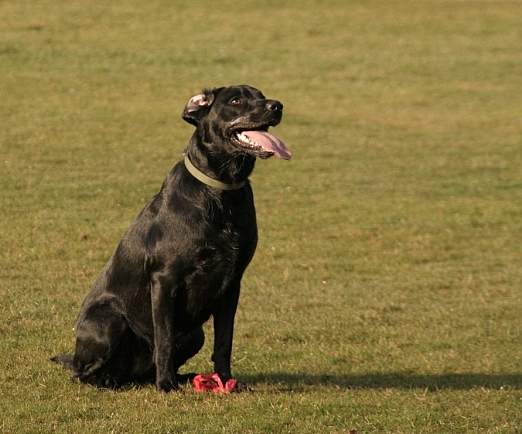
A happy subject is a good subject
Practical considerations
How many shots should you take? It varies with the dog and your situation. Have no expectations and you will not be disappointed. If the dog is getting bored or spooked stop immediately. They will get irritated if you keep shooting and they are not enjoying it or are uncomfortable. Little and often is the key. Expect to get little co-operation from the dog unless you wait for it to quieten down or it is well trained. You have no option but to do a portrait with the dogs’ consent. Investing a little time to get it comfortable may reduce the shots you take. However, they will be more relaxed and natural.
Taking lots of shots does not guarantee success. A few carefully planned and appropriate shots are better. Your success rate will depend mostly on patience and preparation. As with any photography the ones you think will be great shots may not be so… There will also be surprise results.
Health and safety
It is important to think about health and safety when working with animals. If you are working with your own dog it is easier to keep yourself safe. With luck, you’ll know your dogs reactions to the things you do. A strange dog is different. They can be wild and unpredictable to you. Asking the owner a few questions about what the dog likes and dislikes could prevent harm or injury. While the dog is a photo-subject, look after its safety too. Make sure you have not forgotten dangerous roads nearby, or the dangerous ice, other people and children, other dogs… Always have the welfare of you, other people and animals in your care in mind when taking photos.
Consider these points for better shots
- If you have a DSLR multiple shots mode is very useful for dog photographers. It captures the animal multiple times and you might get a great shot in less controlled situations, say while its running.
- Avoid full-on flash. Dogs are easily spooked by it. If you use it reduce the intensity of the flash but make sure the dog is comfortable with it first. Try firing the flash when not holding the camera to your face and make and look completely calm and un-phased. It is best to use always-on lights if you need fill-in light. You can also use a torch or LED light to create catchlights in the eyes, but don’t startle the animal. Get them used to lights first even if only for a minute or two.
- With flash be aware of eye-shine. I have seen various colours from dogs eyes under different lights. The flash-back can be quite bright if it is silver and it can ruin your shot. Off-set the line of the flash from the direct line of the shot.
- I love shots of dogs with a fish-eye lens. In close to the centre of the lens the dog’s long nose and depth to the eyes is emphasised. It really seems to accentuate the character of dogs. Keep the background simple.
- A wide angle lens (not a fish-eye) is best off-set to the side a bit. This really brings the character of the dog forward and the emphasis is on the length of the body and its sleekness.
- If you are working outside, especially on walks, use a longer lens. This gives you scope for catching the dog at all distances.
- Light coloured or white fur are easily blown-out under daytime bright sky, brightly lit rooms or studios. If all the details lost in a mass of white your picture loses impact. Measure your light off the animals’ fur and tone down the exposure to ensure the fur is distinct and detailed.
- Tripods are great if your dog is static. With action shots the tripod is less useful and prevents you following the dog.
- Props are useful with dogs. They love a toy or two. A range of them helps to absorb their attention. New is best. A badly chewed toy is a distraction for the picture viewer.
- Dogs are little individuals. Emphasise this by photographing them without a collar. However, be careful where, make sure you can get them back. Don’t endanger them or others without a way to catch or control them.
A happy subject is a good subject
Relax and enjoy your dog photography. If it is happy the dog will enjoy it too. Stress the dog, or expect too much and you will lose the co-operation of your little friend.
Photographic Glossary – Definitions, articles and resources…
Photographing Dogs series links…
Photographing Dogs – Part 1 – Getting Started
Photographing Dogs – Part 2 – What to focus on.
Photographing Dogs – Part 3 – Getting the shots
Photographing Dogs – Part 4 – Practical Issues
We would love to have your articles or tips posted on our site.
Find out more…
Write for Photokonnexion.


